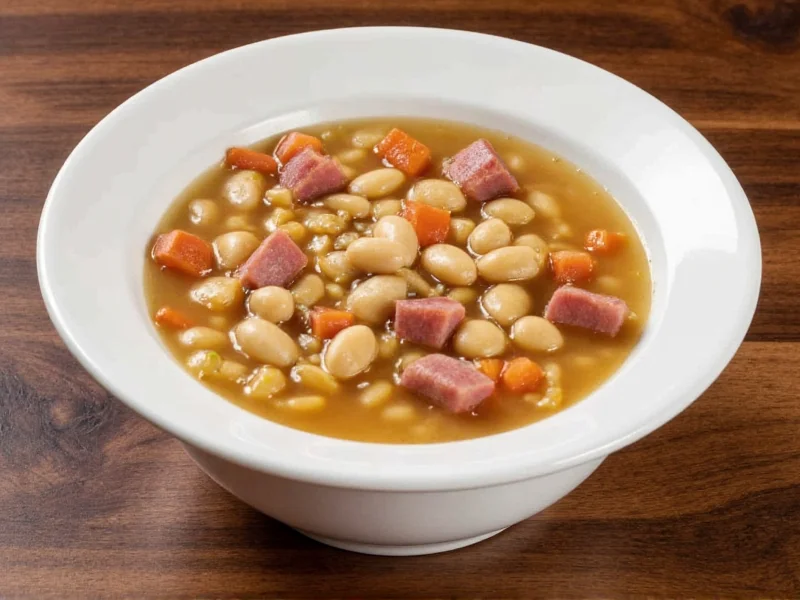The Origins of White Bean Ham Soup
White bean ham soup has roots in European culinary traditions, particularly in French cassoulet and Italian fagioli preparations. These rustic dishes evolved as practical ways to use dried beans and preserved meats during colder months. In American cuisine, the soup became especially popular as a method to transform holiday ham leftovers into a completely new meal. The combination of economical white beans and flavorful ham creates a dish that's both nourishing and deeply satisfying.
Essential Ingredients for Authentic Flavor
Selecting quality ingredients makes the difference between an ordinary and exceptional white bean ham soup. For the best easy white bean ham soup recipe, consider these recommendations:
| Ingredient | Recommended Type | Why It Matters |
|---|---|---|
| White Beans | Cannellini or Great Northern | Creamy texture that holds shape during cooking |
| Ham | Smoked ham hock or leftover baked ham | Provides deep, smoky flavor foundation |
| Aromatics | Fresh onion, celery, carrots | Creates flavor base (mirepoix) |
| Seasonings | Fresh thyme, bay leaf, garlic | Enhances without overpowering |
Step-by-Step Preparation Guide
Follow these steps for the perfect hearty white bean soup with smoked ham:
- Prepare ingredients: Chop 1 onion, 2 celery stalks, and 2 carrots into small dice. Mince 3 garlic cloves. If using dried beans, soak overnight (canned beans require no soaking).
- Sauté aromatics: In a large pot, cook vegetables in 2 tablespoons olive oil over medium heat until softened (about 8 minutes).
- Add ham and beans: Add 1 smoked ham hock or 2 cups diced ham plus 2 cups (16 oz) white beans (canned or soaked dried beans).
- Pour in liquid: Cover with 6 cups chicken or vegetable broth, ensuring ingredients are submerged by 1 inch.
- Simmer: Bring to boil, then reduce heat to low. Cover and simmer 1-2 hours (dried beans) or 30-45 minutes (canned beans) until beans are tender.
- Final seasonings: Remove ham hock, shred meat, return to pot. Add 1 teaspoon thyme, 2 bay leaves, salt and pepper to taste.
Expert Variations and Adaptations
Customize your creamy white bean ham soup variations based on dietary needs or flavor preferences:
- Vegetarian option: Substitute ham with smoked paprika and liquid smoke; use vegetable broth
- Creamy texture: Blend 1 cup soup before adding shredded ham back in
- Spicy kick: Add red pepper flakes or diced jalapeño with aromatics
- Extra heartiness: Stir in chopped kale or spinach during last 10 minutes of cooking
- Leftover ham soup recipe ideas: Add small pasta shapes like ditalini for a more substantial meal
Serving Suggestions and Storage
White bean ham soup reaches its flavor potential when properly served and stored. Ladle hot soup into pre-warmed bowls and garnish with fresh parsley or a drizzle of good olive oil. This traditional white bean and ham soup preparation pairs beautifully with crusty bread for dipping or a simple green salad.
For storage, cool soup completely before transferring to airtight containers. Properly stored, it maintains quality for 4-5 days in the refrigerator or up to 3 months in the freezer. When reheating, add a splash of broth or water as the beans will continue absorbing liquid during storage.
Nutritional Benefits
One serving (1.5 cups) of white bean ham soup typically provides:
- Approximately 280 calories
- 18g protein (excellent plant-based protein source)
- 15g dietary fiber (nearly 60% of daily requirement)
- Rich in iron, potassium, and B vitamins
- Low in saturated fat when prepared with lean ham
The combination of white beans and ham creates a complete protein profile while delivering sustained energy from complex carbohydrates and fiber.
Common Mistakes to Avoid
Even experienced cooks encounter challenges with how to make white bean ham soup from scratch. Avoid these common pitfalls:
- Adding salt too early: Salt can prevent beans from softening properly; add during final seasoning
- Overcooking vegetables: Sauté just until softened to maintain texture and nutrients
- Using poor quality broth: Homemade or high-quality store broth makes a significant difference
- Skipping the resting period: Let soup sit 15-20 minutes after cooking for flavors to meld
- Incorrect bean-to-liquid ratio: Maintain 1:3 ratio of beans to liquid for proper consistency
Frequently Asked Questions
Can I use canned white beans instead of dried beans for ham soup?
Yes, canned white beans work well and reduce cooking time significantly. Use two 15-ounce cans (drained and rinsed) instead of 1 cup dried beans. Add them during the last 30 minutes of cooking to prevent them from becoming too soft.
How do I prevent my white bean soup from becoming too thick?
White bean soup naturally thickens as it cools. To maintain desired consistency, reserve 1-2 cups of broth or water to add when reheating. During initial cooking, keep the soup at a gentle simmer rather than a rolling boil, which breaks down beans too much.
What's the best type of ham to use for authentic white bean ham soup?
Smoked ham hocks provide the most authentic flavor as they contain connective tissue that creates a rich, gelatinous texture. Leftover baked ham works well too - use bone-in pieces for better flavor. Avoid highly processed deli ham as it contains too much sodium and preservatives.
Can white bean ham soup be made in a slow cooker?
Yes, white bean ham soup adapts perfectly to slow cooking. Sauté vegetables first, then transfer to slow cooker with all other ingredients. Cook on low for 6-8 hours or high for 3-4 hours. Add canned beans during the last hour to prevent overcooking.











 浙公网安备
33010002000092号
浙公网安备
33010002000092号 浙B2-20120091-4
浙B2-20120091-4